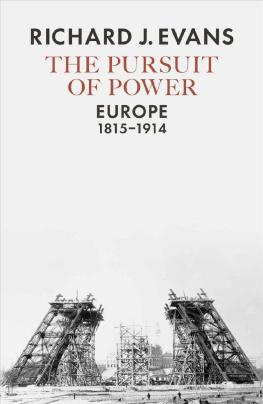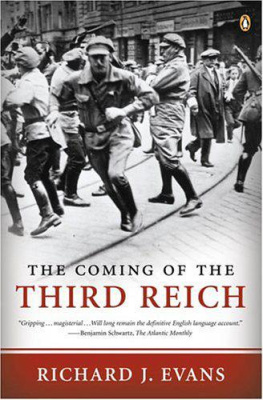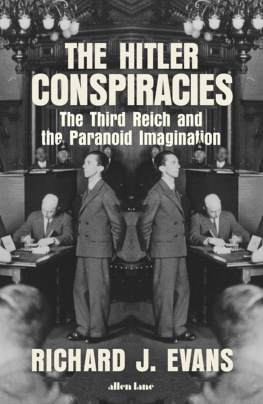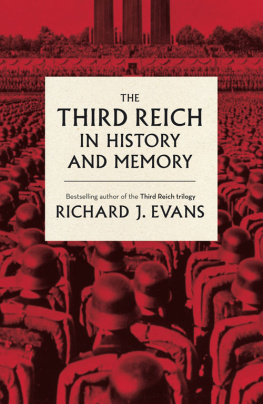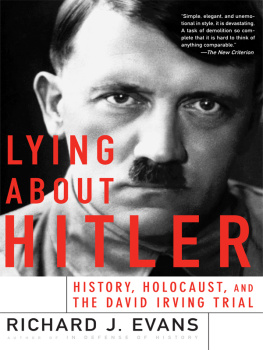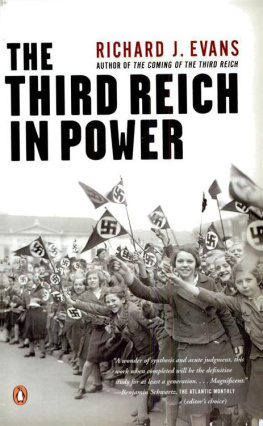Table of Contents
For Matthew and Nicholas
List of Illustrations
1. German troops enter Lodz, September 1939 (photo: Trustees of the Imperial War Museum, London)
2. Ethnic Germans from Lithuania crossing the German border, February 1941 (photo: SV-Bilderdienst/Scherl)
3. Jewish forced labour, Poland, September 1939 (photo: akg-images)
4. Round-up of Jews in Szczebrzeszyn, c. 1939-41 (photo: United States Holocaust Memorial Museum, courtesy of Instytut Pamieci Narodowej)
5. Still from the film I Accuse, 1941 (photo: SV-Bilderdienst/Tobis)
6. Interior of the Brgerbrukeller after the attempt on Hitlers life, 8 November 1939 (photo: akg-images/ullstein bild)
7. Hess visiting the Krupp-AG factory, Essen, May 1940 (photo: akg-images)
8. German tanks in the Ardennes, May 1940 (photo: akg-images/ ullstein bild)
9. Hitler with Speer and Breker at the Trocadro, Paris, June 1940 (photo: akg-images/Heinrich Hoffmann)
10. Fedor von Bock with General Fritz Lindemann in the Crimea, May 1942 (photo: Bayerische Staatsbibliothek, Munich)
11. Grenadiers near Smolensk, September 1941 (photo: akg-images/ ullstein bild)
12. Burning of a Ukrainian farm, September 1941 (photo: bpk/Hhle)
13. German soldiers taking photographs of the execution of Russian partisans, January 1942 (photo: akg-images)
14. Red Army prisoners transported in railway wagons, September 1941 (photo: Bundesarchiv, Koblenz)
15. Car being pulled through the mud, Eastern Front, 1941 (photo: akg-images/ullstein bild)
16. Juden Komplott Gegen Europa (Jewish Conspiracy Against Europe), poster produced by the Reich Ministry for Propaganda and Public Enlightenment, summer 1941 (photo: The Trustees of the Imperial War Museum, London)
17. Heinrich Himmler, Reinhardt Heydrich and Heinrich Mller, November 1939 (photo: Bayerische Staatsbibliothek, Munich/ Heinrich Hoffmann)
18. Auschwitz after its liberation (photo: akg-images)
19. Richard Baer, Dr Josef Mengele and Rudolf Hss, 1944 (photo: USHMM, courtesy of Anonymous Donor)
20. Albert Speer, 1943 (photo: bpk/Hanns Hubmann)
21. Tiger tanks in production, summer 1943 (photo: Bundesarchiv, Koblenz)
22. Street fighting in Stalingrad, 1942 (photo: akg-images)
23. Captured German soldier, Stalingrad, 1943 (photo: Bundesarchiv, Koblenz)
24. Captured German soldiers in the ruins of Stalingrad, January 1943 (photo: AP/PA Photos)
25. German civilian in the streets of Hamburg, December 1943 (photo: AP/PA Photos)
26. Hamburgs main railway station in ruins, 1943 (photo: Museum fr Hamburgische Geschichte, Hamburg)
27. Hans Gunther von Kluge and Gotthard Heinrici, 1943 (photo: Bundesarchiv, Koblenz)
28. Soviet infantry pursue German soldiers whose tank had been hit, August 1944 (photo: akg-images)
29. German leaflet threatening V-1 attacks (photo: courtesy www.psy-warrior.com)
30. Entrance to underground V-2 factory at Mittelbau-Dora, 1944 (photo: bpk/Hanns Hubmann)
31. Hitler on the Oder Front, March 1945 (photo: bpk/Walter Frentz)
32. The Peoples Storm, Hamburg, October 1944 (photo: Hugo Schmidt-Luchs/Ullstein/akg-images)
33. Goebbels meets teenage soldiers at Lauban, Lower Silesia, March 1945 (photo: Bundesarchiv, Koblenz)
34. Hermann Gring, November 1945 (photo: akg-images)
35. Joachim von Ribbentrop c. 1945/6 (photo: akg-images)
36. German women clearing up the debris on Berlins Tauentzienstrasse, 1945 (photo: AP Photo)
Note: The views or opinions expressed in this book and the context in which the images are used do not necessarily reflect the views or policy of, nor imply approval or endorsement by, the United States Holocaust Memorial Museum.
Preface
This book tells the story of the Third Reich, the regime created in Germany by Hitler and his National Socialists, from the outbreak of the Second World War on 1 September 1939 to its end in Europe on 8 May 1945. It can be read on its own, as a history of Germany during the war. But it is also the final volume in a series of three, starting with The Coming of the Third Reich, which deals with the origins of Nazism, the development of its ideas and its rise to power in 1933. The second volume in the series, The Third Reich in Power, covers the peacetime years from 1933 to 1939, when Hitler and the Nazis built up Germanys military strength and prepared it for war. The general approach of all three volumes is set out in the Preface to The Coming of the Third Reich and does not need to be repeated in detail here. Taken together, they aim to provide a comprehensive account of Germany under the Nazis.
Dealing with the history of the Third Reich during the war poses two special problems. The first is a relatively minor one. After 1939, Hitler and the Nazis became increasingly reluctant to refer to their regime as The Third Reich, preferring instead to call it The Great German Reich (Grossdeutsches Reich) to draw attention to the massive expansion of its boundaries that took place in 1939-40. For the sake of unity and consistency, however, I have chosen, like other historians, to continue calling it The Third Reich; after all, the Nazis chose to abandon this term silently rather than repudiate it openly. The second problem is more serious. The central focus of this book is on Germany and the Germans; it is not a history of the Second World War, not even of the Second World War in Europe. Nevertheless, of course, it is necessary to narrate the progress of the war, and to deal with the Germans administration of the parts of Europe they conquered. Within the scope even of so large a book as this, it is not possible to pay equal attention to every phase and every aspect of the war. I have chosen, therefore, to focus on the major turning-points - the conquest of Poland and France and the Battle of Britain in the first year of the war, the Battle of Moscow in the winter of 1941- 2, the Battle of Stalingrad in the winter of 1942- 3, and the beginning of the sustained strategic bombing of German cities in 1943. In doing so, I have tried to convey something of the flavour of what it was like for Germans to take part in these vast conflicts, using the diaries and letters of both soldiers and civilians. The reasons for choosing these particular turning-points will, I hope, become apparent to readers in the course of the book.
At the heart of German history in the war years lies the mass murder of millions of Jews in what the Nazis called the final solution of the Jewish question in Europe. This book provides a full narrative of the development and implementation of this policy of genocide, while also setting it in the broader context of Nazi racial policies towards the Slavs, and towards minorities such as Gypsies, homosexuals, petty criminals and asocials. I have tried to combine the testimony of some of those it affected - both those who survived, and those who did not - with that of some of the men who implemented it, including the commandants of major death camps. The deportation and murder of Jews from Western European countries is covered in the chapter dealing with the Nazi empire, while the reactions of ordinary Germans at home, and the extent to which they knew about the genocide, are covered in a later chapter on the Home Front. The fact that the mass murder of the Jews is discussed in almost every part of the book, from the narrative of the foundation of the ghettos in Poland in the opening chapter right up to the coverage of the death marches of 1945 in the final chapter, reflects its centrality to so many aspects of the history of the Third Reich at war. Wherever one looks, even for example in the history of music and literature, dealt with in Chapter 6, it is an inescapable part of the story. Nevertheless, it is important to reiterate that this book is a history of Nazi Germany in all its aspects; it is not in the first place a history of the extermination of the Jews, any more than it is a history of the Second World War, though both play an essential role in it.




